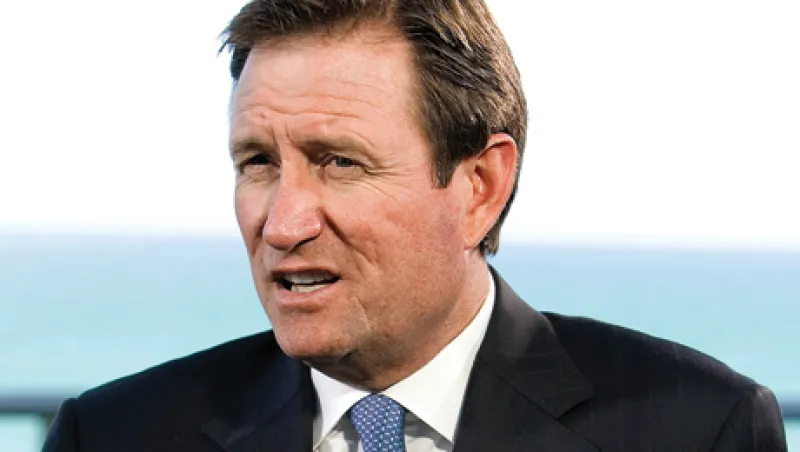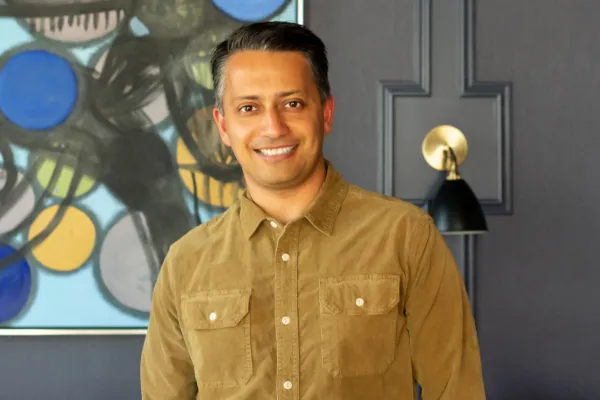Mining is in Charles Jeannes’s blood. He grew up in Nevada, a state that is the largest producer of gold in the U.S. and would rank third or fourth in the world were it an independent country. His father was part of a small group of investors who bought and revived an abandoned gold and silver mine in Nevada. Though the venture failed after prices fell, the investment sparked an interest in mining on the part of the younger Jeannes. But he also wanted to be a lawyer. After getting a BS in business and political science from the University of Nevada, he earned a law degree from the University of Arizona, which had a mining and environmental law program, in 1983 and practiced law until 1994 as head of the natural-resources section at Woodburn and Wedge in Reno.
Jeannes eventually took a job with his biggest client, Placer Dome, a Canadian gold mining company, then moved to Glamis Gold, a Reno-based gold miner, where he was executive vice president, general counsel and secretary until Glamis merged with Goldcorp in November 2006. He became Goldcorp’s CEO in December 2008.
His company has had a tough year, dealing with water shortages in Mexico, where it operates three mines, and coping with seismic activity that has reduced production at its Red Lake mine in Ontario, Canada. In early July, Goldcorp, the second-largest gold mining company after Barrick Gold Corp., warned that those problems would cause its gold output to decline this year. Earnings fell 45 percent in the second quarter of 2012 from the same period a year earlier, to $268 million, on a 15 percent decline in revenue, to $1.1 billion.
Notwithstanding its current difficulties, the company operates low-cost mines in stable regions of the world and has a rich pipeline of new mines, analysts note. Goldcorp employs 14,000 people and has five mines in Canada and the U.S., three in Mexico and one each in Argentina, the Dominican Republic and Guatemala. It has two more under development, one in Argentina, the other in Guatemala. Those properties are valuable assets because the supply of gold, regardless of its price, is not expanding.
Institutional Investor Senior Writer Julie Segal met with Jeannes recently to discuss how Goldcorp is meeting these and other challenges.
Institutional Investor: Macroeconomic forces have become increasingly volatile. What’s it like to operate in this climate?
Jeannes: If you put the gold price on a chart and laid it next to the Dow Jones over the past 15 years, you’d find that gold is no more volatile, which is quite different from historical views. We’re impacted by volatility in our commodity pricing, and our business is different in that we have no control over our revenues as a result. That makes a particularly challenging business, but it’s just something we have to deal with.
That said, it’s been a fantastic business to be in because we’re part of an overall commodity, hard-asset supercycle that’s been in place for going on 15 years. It’s generally followed the rise of demand from emerging economies like China, but there are a lot of other reasons for the increase in the gold price. It’s really changed our business over the past decade.
Tell us about those changes.
In the ’80s and ’90s, all we were was an option on the gold price. Anyone who wanted exposure to the optionality of the gold price had two choices: They could buy coins and other kinds of physical gold, which carry challenges for storage and insurance and the like, or they could buy gold equities. ETFs gave them a very viable third choice and so required gold equities to be more disciplined and generate returns like any other business. That’s changed the nature of our entire sector.
The downside is that some of the demand that could previously have gone into gold equities is no longer there. People are simply buying the ETF and not looking to our business. But the net effect has been quite positive because it’s created a whole new class of investors who previously wouldn’t have looked at any kind of gold investment. And once investors become comfortable with a sector, they look for opportunities to improve their returns, and we think we provide leverage to the gold price that the ETF doesn’t. We grow organically, both through exploration and by delivering on these projects that we’ve already got on hand. And so we find that as new investors come in and get comfortable with gold, they often then look to the equities and companies like Goldcorp for enhanced returns.
That sounds like a huge change.
It’s mainly cultural, because both the company that I came from, Glamis Gold, and Goldcorp before we merged were start-ups that bought assets and grew dramatically with the construction of a few new mines. But you didn’t need all of the financial and human resources, and risk management, and IT, and other functions of a business that are required for long-term success, so much of what we’ve been doing over the past several years has been building that capacity. Some of our peers, like Barrick or Newmont, have been around for 20-plus years and had quite a head start, so we’ve been working very hard to build that capacity, and I think we’ve done a good job.
How do you maintain the entrepreneurial spirit of the company?
That’s the trick. You don’t want to stifle that entrepreneurial spirit that made us so successful as smaller companies. We’ve all been very focused on not building a bureaucracy, not putting in so much process and procedure that we stifle the initiative and entrepreneurial culture that we have.
What are your competitive advantages?
We’ve had for the past five years strong cash flow and low-cost production, combined with a low political risk profile because we’ve chosen to grow in areas of relatively low political risk. We’ve also had a strong, and some would say too conservative, balance sheet. And we’re growing production more than 50 percent over the next four-plus years. That’s based on constructing mines that we acquired, in some cases, many years ago. We see very strong growth and cash flow and earnings over the coming years, based on that new production.
What initiatives are crucial to your future growth?
We just need to execute. We’ve had operational issues that required us to lower our guidance for the year back in July. And those kinds of things scare people away from us as an investment and back to the ETF.
You’ve encountered water supply issues at Peñasquito and permit problems in places like Chile. How do you manage those uncertainties?
We’re strengthening our enterprise risk management system so that we identify risks and quantify them so that neither we nor our investors are surprised if certain things happen. I don’t accept that some things are beyond our control. Clearly, they are. But we get paid to manage those things, and I think we can. At Peñasquito, had we done a better job of assessing that risk, we would have known and communicated to the market that there was a risk that water supply would be less than what we needed, and then when it happened it wouldn’t have been such a negative surprise. You can manage those things if you identify and report on these kinds of risks and work them into your forecasts better than we did.
Talk a little bit about the other risks facing your company, including what you call resource nationalism.
The No. 1 risk to our business overall is that governments have been in deficit spending mode and looking for new sources of revenue. So they’ve been increasing royalties, increasing taxes. We need to do a much better job educating governments as to the costs of doing business. We have significant capital investments that we need to make, and if you look at it all, we’re not making windfall profits. Those kinds of discussions with governments tend to be had after some proposal comes out to increase a tax.
It’s the nature of mining, though, that you’re dependent on a government for support.
People think that we have no choice but to go into a certain country because that’s where the gold is. But we can choose to look for gold in a place or not, and if the government has proven to be particularly problematic, we won’t go there, and they need to understand that.
Mining is hardly uncontroversial. How big a risk does the potential backlash represent?
I’d look very directly at Guatemala and the Marlin mine there. There was negative press and some opposition to the mine, largely based on lack of understanding of what it was really about. As time has gone on, we’ve seen a tremendous increase in the health and prosperity of the communities around the mines. The number of children who are attending school has gone up by 70 percent over the past five years, because their families now have the wherewithal to let them go to school rather than helping out in the fields.
There is a finite supply of gold in the world, and yet you have to be constantly on the lookout for new opportunities. Tell us about that dynamic.
If you look at mine supply over the past ten years, it’s been pretty flat, and the prognosticators continue to say that with the increased price and investment, there will be more gold mined in the future. But that hasn’t happened, because this is a difficult business. It’s technically difficult. It’s difficult to get your permits. In some countries it’s difficult to operate at all, so I expect mine supply to continue to be relatively flat over the next ten years. And on the demand side, you’ve got billions of people in China and India and other emerging economies who are creating wealth and looking to invest, and have a cultural affinity for gold.
Goldcorp is known mostly for gold, but you produce other metals as well. How important is this?
We produce copper, lead, zinc and a lot of silver. I think this year we’ll be the third-largest silver producer in the world. That’s as a by-product, primarily from our Peñasquito mine in Mexico but also some of our other gold mines. There are people who focus on silver as an investment, and I think it’s a bit of a hidden value in our company. Copper, lead and zinc is a smaller part of our revenue stream but provides a bit of diversity and smoothing out of revenues quarter-to-quarter. We will always remain a gold company, but having a bit of base metal by-product has been positive.
What’s the most challenging part of being a CEO of a public company?
In the gold mining business, it may take you five years just to get a mine built, but then it will last for another 20 or 30 years. We’re making very long-term decisions, but we’re being judged by our investors on an increasingly short-term basis. It used to be challenging because of the focus on quarter-by-quarter performance. Today it seems investors want to know what’s going on on a month-to-month and week-to-week basis. • •







